Technology
After all the leaks Samsung unveils the 180-degree hinge Galaxy Z Flip which ships on February 14
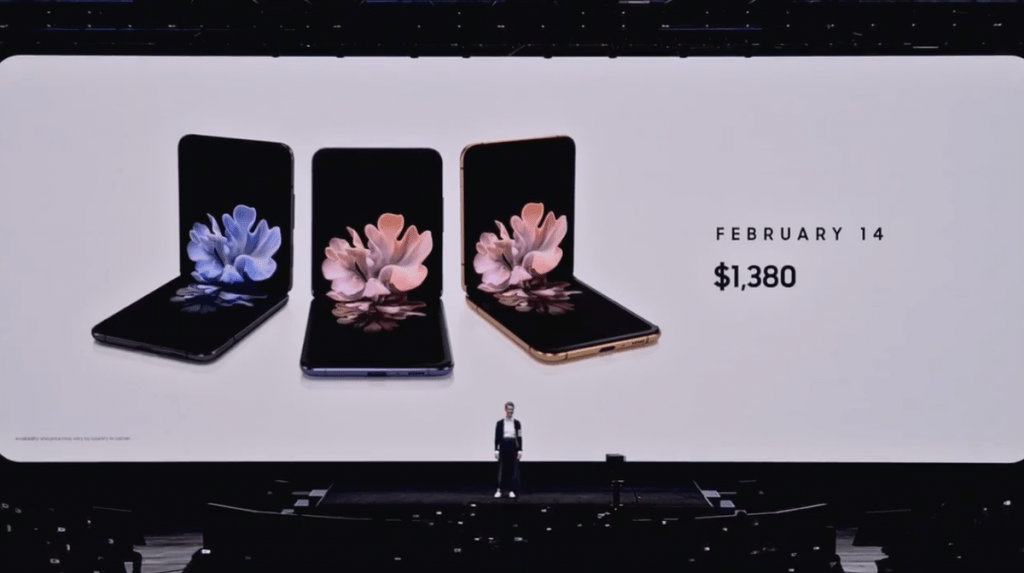
Today at the Bill Graham Civic Auditorium in San Francisco, the company announced the Galaxy Z Flip, a handset with an outward-facing display that unfurls to reveal a bendable panel within. It’s Samsung’s answer to Motorola’s reimagined Razr and TCL’s DragonHinge concept, and while its internals are middle-of-the-road, its price is more reasonable than might be expected.
The Galaxy Z Flip will begin shipping to customers who preorder on February 14. Here’s what you need to know.
Design
The Galaxy Z Flip is a smartphone in two congruent parts: A top portion housing the external display — the Focus Display — above which sits twin cameras and an LED flash, attached to a bottom portion via a hinge that supports the tall internal screen. In a briefing in early January, Samsung Telecommunications CEO DJ Koh said that the design was inspired by Lancôme’s makeup compacts, and that 20-something women are one of the target demographics.
The outward-facing Super AMOLED panel measures 1.06 inches diagonally with a resolution of 300 x 112 and Corning Gorilla Glass 6 shielding, which is rated to withstand up to 15 consecutive drops from 1 meter onto rough surfaces. Taking a page from the Motorola Razr, the screen dims when it’s not in use and otherwise displays the time, battery, charging status, and notifications. And when a phone call comes in, it shows the caller ID, as well as sliders for rejecting or accepting the call.
The cameras above the display — which double as selfie cameras, with the screen serving as a viewfinder — share a resolution (12 megapixels) but not a field of view. One has a 123-degree wide-angle field of view and an f/2.2 aperture and optical image stabilization, while the other has a 78-degree field of view and an f/1.8 aperture. Both can shoot video in up to 4K resolution at 60 frames per second, and they benefit from Samsung’s Pro Video Mode, which offers fine-grained control over each clip.
The cameras are one of the few distinguishing features on the otherwise feature-less Galaxy Z Flip, save a capacitive fingerprint sensor and a volume rocker on the right side and a USB Type-C port and speaker grille toward the bottom.
Unfurling the Z Flip reveals the 6.7-inch Dynamic AMOLED Infinity Flex primary panel, which has a 2,636 x 1,080 resolution (425 pixels per inch), a 21.9:9 aspect ratio, and a top-center hole-punch cutout to accommodate the front-facing camera. The camera in question is 10 megapixels in resolution with an f/2.4 aperture and an 80-degree field of view, and it features a software-defined auto-focusing algorithm that hones in on the faces it detects.
‘Ultra Thin Glass’
Durability questions rightly abound about bendable displays, these days — the new Razr survived a test by CNET only for 27,000 folds and the Galaxy Fold was plagued with problems that forced its temporary removal from store shelves. But if Samsung is to be taken at its word, the Z Flip’s display glass technology — Ultra Thin Glass — will stave off the issues foldable phones have faced so far.
How? Well, according to Samsung, Ultra Thin Glass is pre-creased in the middle to strengthen it against abuse that might lead to artifacting. (It’s rated to last up to 200,000 folds.) It’s also made of glass as opposed to plastic (as the name implies), which is noteworthy — both the Razr and the Fold have plastic screens.
Beyond the improved robustness, Samsung says Ultra Thin Glass enabled it to shave millimeters off the phone’s thickness and ounces off its weight. The Z Flip is just 7.2 millimeters when opened and 15.3-17.33 millimeters when closed, and it weighs 6.9 ounces — 0.3 ounces lighter than the new Motorola Razr (7.2 ounces).
The hinge, too — Samsung calls it Hideaway Hinge — is less damage-prone thanks to nylon microfibers designed to prevent dust particles from entering. (Before it was reengineered and rereleased, the Galaxy Fold’s panel had a habit of developing bumps after particles crept in underneath, eventually damaging the display.) It also features what Samsung is calling a Free Stop design, which allows the two 4-inch halves to bend and stay in place at any angle up to 180 degrees.
Connectivity, processor, and audio
The Galaxy Z Flip packs Qualcomm’s Snapdragon 855+, a capable system-on-chip that’s the successor to the Snapdragon 855. The 7-nanometer eight-core chip can achieve download speeds up to 2Gbps over cellular, and it supports Wi-Fi 6 (aka 802.11ax), along with 802.11ac Wave 2 for superior wireless performance on pre-802.11ax networks.
Four 64-bit ARM Cortex cores based on Qualcomm’s in-house Kryo 485 handle the heavy lifting — one prime core clocked at 2.95GHz and three performance cores at 2.41GHz — while four 1.78GHz efficiency cores handle less performance-intensive tasks. Somewhat uniquely, the Snapdragon 855+ diffuses AI capabilities across multiple components (including a tensor accelerator) for a theoretical capacity of trillions of operations per second.
Meanwhile, the Snapdragon 855+’s graphics chip is substantially faster than the Snapdragon 855’s, and it supports HDR (along with APIs like Vulkan 1.1) and algorithms designed to reduce dropped frames. The system-on-chip also supports physically based rendering (PBR) to replicate the way light reflects off of real-world materials. And its redesigned camera pipeline moves computer vision features directly into the ISP, such that the Spectra ISP, which sports multiple CV-ISPs, allows for video capture and object classification in addition to real-time segmentation.
AKG-tuned speakers
The Galaxy Z Flip plays play stereo sound through the earpiece and a bottom-firing loudspeaker. They’re both tuned by AKG Acoustics and support the Direct Stream Digital (DSD) format (64/128) and Dolby’s Atmos 3D simulated surround sound technology in supported apps.
Battery life, memory, storage, and connectivity
Like newer entries in Samsung’s Galaxy S and Notes series, the Galaxy Z Flip supports Samsung’s Adaptive Fast Charging tech and Fast Wireless Charging 2.0 (at 12 Watts) via Qi. Hardware acceleration for H.265 and VP9 codecs, courtesy of the Snapdragon 855, improves power efficiency by 7 times compared with the Snapdragon 845. Plus, Samsung’s software-defined Adaptive Power Saving tech optimizes battery performance based on app use.
That will hopefully compensate for the Galaxy Z Flip’s middling dual battery capacity (3,300mAh), which is about three-fourths of the Galaxy Fold’s (4,380mAh). But to be fair, the Z Flip delivers more power than the new Motorola Razr (2,800mAh), and it boasts Samsung’s wireless power-sharing feature — PowerShare — allowing it to recharge accessories when they’re placed on the phone’s rear cover.
Elsewhere inside the Z Flip, there’s 8GB of RAM paired with 256GB of storage, and chips that support Wi-Fi 802.11 a/b/g/n/ac/ax (Wi-Fi 6) and Bluetooth 5.1. Dual SIM dual standby (DSDS) is present and accounted for, meaning that Z Flip’s SIM and eSIM can work simultaneously. But 5G compatibility is a no-go — it’s strictly a 4G affair.
Software
Samsung says it worked with Google to optimize Android for the Z Flip’s foldable screen. The phone behaves somewhat like a tablet unfurled, with an enhanced multitasking Multi-Active Window feature that takes advantage of the added real estate. If you’re looking at Google Maps, for example, the top-down view expands to show a larger area on the internal screen, while supported video conferencing apps let you bend the Z Flip at a 90-degree angle for a hands-free experience.
In point of fact, the two halves of the Z Flip act independently in many scenarios, somewhat like a split-screen interface for using two apps side by side. Not unlike the LG G8 and G8X, which debuted alongside a Dual Screen accessory that added a secondary screen, one display on the Z Flip optionally functions as a separate viewing area while the other serves as a control area.
To further shore up early software support for the form factor, Samsung is making available an emulator that allows developers to test things like how apps change when they transition from a “folded” to an “unfolded” state. It’s also partnering with a select group of partners to build bespoke experiences for the Z Flip.
OneUI 2.1
Like the Galaxy S10 series before it, the Galaxy Z Flip runs One UI 2.1, Samsung’s redesigned overlay atop Android 10.
OneUI 2.1 brings with it quality-of-life improvements like a screen recorder with controls that let you adjust the resolution, record external and internal microphone audio, and more, in addition to an enhanced dark mode that works with a wider selection of apps and time-based triggers. In other news, One UI 2.1 adopts the iOS-like navigation gestures introduced in Android 10, including a one-handed mode that can be accessed with a swipe down on the gesture bar.
The camera app is a bit easier to use in OneUI 2.1, thanks to a streamlined design with a drag-and-drop gesture that puts photo and video modes at your fingertips. And thanks to Samsung’s ongoing partnership with Microsoft, the Gallery app now integrates with OneDrive.
In other improvements, non-app shortcuts can now be added to the lock screen, including for Do not disturb and the flashlight. OneUI 2.1 ships with the latest version of Google’s Digital Wellbeing, which features a focus mode that disables all notifications and apps so you can focus on work and other things. Plus, the revamped Device care section of the settings menu lets you decide when Wireless PowerShare should stop charging other devices.
Samsung teamed up with Google to optimize Google Duo video calls on the Z Flip, the companies said. You’re able to launch a chat with up to eight friends in 1080p quality from the dialer app. And thanks to an ongoing collaboration with Spotify, the Z Flip’s default keyboard lets you quickly search and share songs, albums, and playlists from Spotify via a generated link, and Samsung’s clock app lets you choose a song to wake up to.
Bixby
One UI isn’t the Galaxy Z Flip’s only spotlight software feature. There’s Bixby Vision, which taps computer vision to recognize and classify objects in photos, much like Google’s Google Lens and Amazon’s Flow. As for Bixby Voice, Samsung’s answer to Amazon’s Alexa and Google Assistant, it works just as it does on Samsung’s other flagship devices — say “Hey, Bixby” or hold down the Bixby key to prime it for commands like “What’s the weather forecast?” and “Call John.”
Bixby, like any modern voice assistant, recognizes requests to add items to your calendar, queue up tunes, place calls, and launch apps, and it can answer basic questions about sports scores, movie showtimes, business hours, and more. Additionally, thanks to newly released developer tools (Bixby Developer Studio, Bixby Templates, and Bixby Views) and a digital storefront (Bixby Marketplace), it supports a greater number of third-party apps and services than ever before.
Bixby also boasts Bixby Routines. Much like Alexa Routines and routines on the Google Assistant, Bixby offers preset and personalized routines, such as Driving and Before Bed routines, which can be customized based on your habits.
Pricing and availability
Most foldable phones on the market aren’t cheap — the Galaxy Fold starts at $1,980 — and Samsung isn’t bucking the trend with the Galaxy Z Flip. At $1,998, it’s hardly within striking distance of the new Motorola Razr ($1,500), which has a weaker system-on-chip (the Snapdragon 710), and it’s only slightly less pricey than Huawei’s flagship Mate X (about $2,403). Time will tell whether it’s a price point the average customer is willing to reconcile; Samsung reported in early January that it had only managed to sell 400,000 or 500,000 Galaxy Fold units. It’s reportedly aiming to sell 2.5 million Galaxy Z Flips.
The Galaxy Z Flip is available in three colors at launch — Mirror Black, Mirror Purple, and in select markets Mirror Gold — and it starts at $1,380. (Access to YouTube Premium is included with every purchase.) An edition of the Galaxy Z Flip designed in collaboration with Thom Browne is forthcoming, with details to come later this week.


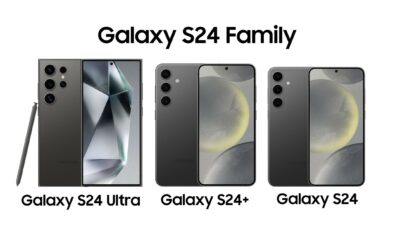
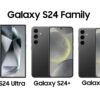
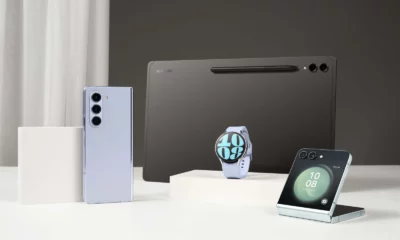
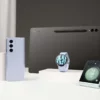
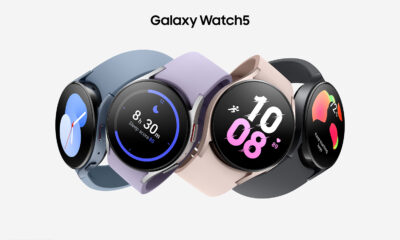

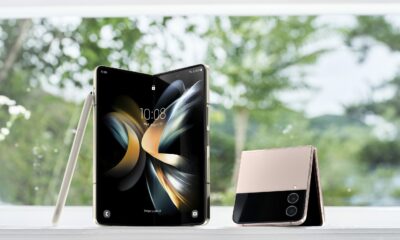
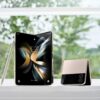




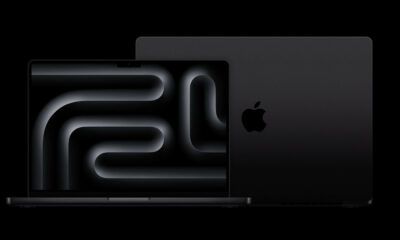

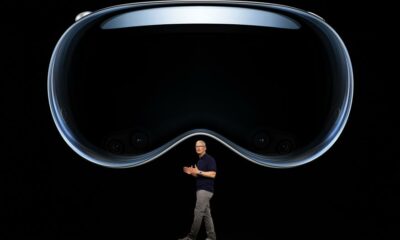

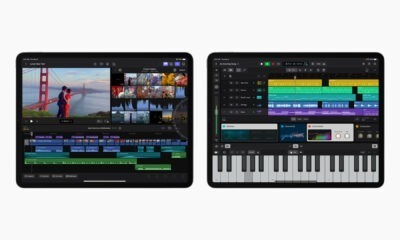
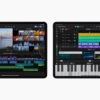





Recent Comments